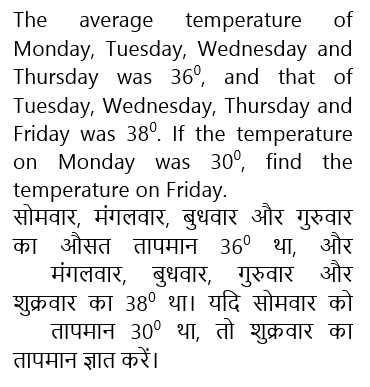Question 1: 
Question 2:
The current age of Anamika is three times that of Surekha. After 7 years, the ratio of Surekha’s age to that of Anamika’s age will be 4:7. Then the current age of Anamika will be:
अनामिका की वर्तमान आयु सुरेखा की तीन गुना है। 7 वर्षों के बाद, सुरेखा की उम्र और अनामिका की उम्र के अनुपात 4: 7 होगा। तब अनामिका की वर्तमान उम्र होगी?
Question 3:
Average weight 29 kids of a play school is 12 kg. If the weight of a teacher is included then the average increases by 500 gram. Find the weight of the teacher.
एक प्ले स्कूल के 29 बच्चे का औसत वजन 12 किग्रा हैं। यदि एक शिक्षक का वजन शामिल किया जाता है तो औसत 500 ग्राम तक बढ़ जाता है।शिक्षक का वजन ज्ञात कीजिए।
Question 4:
The price of 20 chairs is equal to that of 8 tables. The price of 30 chairs and 4 tables together is Rs 12000. Find the total price of 24 chairs and 6 tables.
20 कुर्सियों की कीमत 8 टेबल के बराबर है। 30 कुर्सियों और 4 टेबलों की कीमत 12000 रुपये है। 24 कुर्सियों और 6 टेबल की कुल कीमत ज्ञात करें।
Question 5:

Question 6:
A sum of cash is borrowed and paid back in 2 annual installments of Rs.648 each allowing 10% CI. The sum borrowed was
नकदी की एक राशि उधार ली जाती है और 648 रुपये की 2 वार्षिक किस्तों में भुगतान की जाती है जो प्रत्येक पर 10% चक्रवृद्धि ब्याज की अनुमति देती है। उधार ली गयी राशि क्या थी?
Question 7:
7/11 part of the citizens in a town are male. If 44% of the males are married, the percentage of unmarried female in the total population is.
एक शहर में नागरिकों का 7/11 हिस्सा पुरुष हैं। यदि 44% पुरुष विवाहित हैं, तो कुल जनसंख्या में अविवाहित महिला का प्रतिशत क्या है?
Question 8:
A certain work is completed when Sarvesh worked alone for 20 days and left, followed by Rajesh working alone for 24 days and leave, and finally Senthil finishing it in 10 days. If the ratio of work alone by Sarvesh, Rajesh and Senthil is 7:14:10 respectively, then what is the ratio of efficiencies of Sarvesh, Rajesh and Senthil?
एक निश्चित काम पूरा हो गया है जब सर्वेश ने 20 दिनों तक अकेले काम किया और छोड़ दिया, उसके बाद राजेश ने 24 दिनों तक अकेले काम किया और छोड़ दिया, आखिरकार सेंथिल ने इसे 10 दिनों में पूरा कर दिया। यदि सर्वेश, राजेश और सेंथिल द्वारा अकेले काम का अनुपात क्रमशः 7:14:10 है, तो सर्वेश, राजेश और सेंथिल की क्षमता का अनुपात क्या है?
Question 9:
How many words can be formed by arranging the letters of the word BLASTED such that B and E are never come together?
BLASTED शब्द के अक्षरों की व्यवस्था करके कितने शब्दों का गठन किया जा सकता है ताकि B और E कभी साथ नहीं आंये?
Question 10:
Breadth of a rectangle is equal to the side of a square while length of the rectangle is 50% more than its breadth. Find the perimeter of rectangle if area of rectangle is 128 sqcm more than area of given square
एक आयत की चौड़ाई, एक वर्ग की भुजा के बराबर है जबकि आयत की लंबाई इसकी चौड़ाई से 50% अधिक है। आयत की परिधि ज्ञात करें यदि आयत का क्षेत्रफल, दिए गए वर्ग के क्षेत्रफल से 128 वर्ग सेमी अधिक है।









